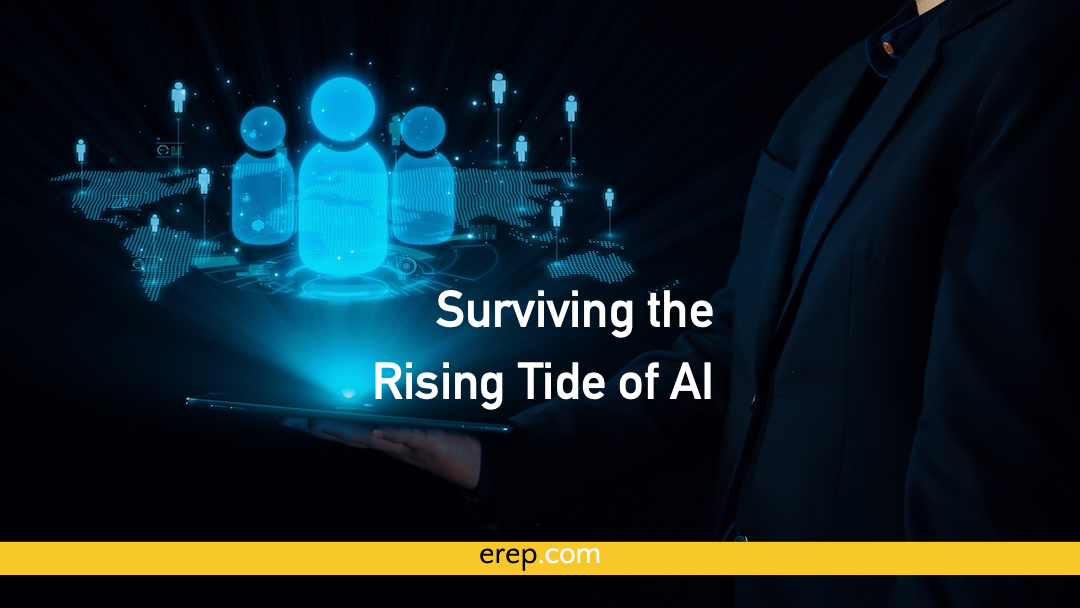Surviving the Rising Tide of AI
- By
- Devin Partida, Contributor
- Posted
- Monday, April 7, 2025

Artificial intelligence (AI) is a rising tide, disrupting the workplace hierarchy and employers' expectations. It is sink or swim for everyone, from potential hires to career employees.
Instead of fighting the powerful current of change, businesses must pivot. However, many are treading water, unaware of how to adapt. In these uncertain times, upskilling and reskilling are a lifeline.
HR Can Upskill and Reskill to Generate Business Value
The workforce is experiencing the calm before the storm. According to the World Economic Forum's Future of Jobs report — which surveyed over 800 firms across 27 industries — an estimated 66% of business-related tasks are performed by humans, while 34% are executed by machines.1 As AI's presence grows, this figure will increase.
Even the storm cloud of AI has a silver lining.
Although intelligent algorithms are an incredibly powerful tool, they are not all-powerful. Every subset, from large language models to deep learning algorithms, has problems with soft skills.
This technology is not always more capable than employees. Scientists proved this when they reconstructed 1 cubic millimeter of a human brain, which contained approximately 1.4 petabytes of data.2 For reference, OpenAI's GPT-4 training dataset contains around 1 petabyte, meaning it does not even compare to this minuscule portion of the human brain.
When push comes to shove, humans' critical thinking and problem-solving will outperform AI. However, they cannot think nearly as fast as an algorithm can compute, giving it an advantage. If human resources (HR) professionals use upskilling and reskilling to close this gap, they can soothe career-concerned workers while generating business value.
Soft Skills for an Increasingly AI-Focused Job Market
LinkedIn research shows that 92% of organizations value soft skills as much as — or even more than — technical skills.
Talent management professionals should focus on strengthening personal attributes, including teamwork, emotional intelligence and leadership. LinkedIn research shows that 92% of organizations value soft skills as much as — or even more than — technical skills.3 The easiest way to keep employees' heads above water is to bridge this gap.
While generative models may seem capable of creativity, they are not. They struggle with this skill because they cannot produce text, images, video or audio without human input. If their training dataset is too small, irrelevant or outdated, the quality of their work deteriorates.
What happens when algorithms have read everything? Even if they recursively train on data generated by previous generations, they will experience performance and accuracy issues. In time, model collapse will occur. Companies need a human-in-the-loop system to source new data points. Otherwise, they risk a failed investment.
Curiosity is a soft skill these algorithms cannot possess.
Unlike humans, they do not thirst for knowledge or seek opportunities to better themselves. While they run autonomously, they must follow their training. Similarly, emotional intelligence — a skill ideal for empathetically delivering feedback and understanding staff members' needs — is impossible for them.
In-Demand AI Skills That Provide a Competitive Edge
In light of rapidly progressing automation, HR professionals should consider reskilling. Team members will likely be receptive. LinkedIn's 2024 Workplace Learning report revealed that approximately 80% of employees want to learn more about using this tool in their profession.4 This optimism could support pilot programs.
Yes, AIs can hallucinate. It's the term experts use to refer to false or incorrect outputs.
Workers could be trained to manage hallucinations or identify algorithmic bias. Alternatively, prompt engineering — developing and optimizing input to produce the best possible outcome from generative technology — could become part of their roles. They must be trained to be the individual that gets kept in the human-in-the-loop system.
According to Jim Chilton, the chief technology officer at Cengage Group, the rise of AI in the workplace has caused a surge in demand for new C-suite roles.5 He warns that those who do not embrace the technology to accelerate their growth will be left behind.
Methods for Acquiring and Enhancing These Skills
A Forbes Advisor survey revealed that 35% of business owners feel anxious about the technical abilities employees will need to use AI tools efficiently.6 How can HR teams ensure staff members acquire and enhance these skills?
Since AI technology is relatively new, few in-house teams can offer relevant expertise.
Luckily, numerous other options exist. Ongoing learning opportunities include online courses, workshops, mentorships and certifications. With these programs, people can adapt to — and even thrive in — their evolving workforce.
Of course, there are education-related expenses to consider. In the United States, employee training costs ranged from $544 to $1,105 per person in 2023.7 The exact amount varied depending on whether they worked at a small business or large enterprise. Determining which program is best requires careful consideration of costs.
Workers Can Stay Afloat Despite the Rising Tide of AI
It is normal to feel underwater, given the circumstances. How can individuals pivot so sharply after spending years honing their current skill set? While this task may seem impossible, they must remember that upskilling and reskilling are their life jackets. Leaning on their employers will help them adapt and remain in their profession.
NOTES
[1] https://www.weforum.org/publications/the-future-of-jobs-report-2023/digest/
[2] https://rehack.com/ai/artificial-consciousness/
[3] https://www.watermarkinsights.com/resources/blog/soft-skills-professional-development-curriculum/
[5] https://www.cio.com/article/641589/how-ai-is-reshaping-demand-for-it-skills-and-talent.html
[6] https://www.forbes.com/advisor/business/software/ai-in-business/
[7] https://www.statista.com/statistics/1418350/onboarding-training-cost-per-employee-us/
Go to eRep.com/core-values-index/ to learn more about the CVI or to take the Core Values Index assessment.

Devin Partida
Contributor
Devin Partida researches and writes about technologies in the business, HR and career spaces. Her passion for HR tech in particular has led to her work being featured on such industry publications as Talent Culture, OHS Online, Boss Magazine and Startups Magazine, among other respected websites. Devin is also the Editor-in-Chief of the growing technology publication ReHack.com, where she frequently writes and edits pieces on smart tech, apps and various technology trends.
View additional articles by this contributor
Essentials
Additional Reading
Stay Updated
Employer Account Sign-up
Sign up for an employer account and get these features and functions right away:
- Unlimited Job Listings on eRep.com
- Applicant Search
- Applicant Tracking System (ATS)
- Unlimited Happiness Index employee surveys
- 3 full/comprehensive CVIs™
- No credit card required — no long-term commitment — cancel at any time
Write for eRep
Are you interested in writing for eRep? Read our submission guidelines.
